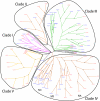Cross genome comparisons of serine proteases in Arabidopsis and rice
- PMID: 16895613
- PMCID: PMC1560137
- DOI: 10.1186/1471-2164-7-200
Cross genome comparisons of serine proteases in Arabidopsis and rice
Abstract
Background: Serine proteases are one of the largest groups of proteolytic enzymes found across all kingdoms of life and are associated with several essential physiological pathways. The availability of Arabidopsis thaliana and rice (Oryza sativa) genome sequences has permitted the identification and comparison of the repertoire of serine protease-like proteins in the two plant species.
Results: Despite the differences in genome sizes between Arabidopsis and rice, we identified a very similar number of serine protease-like proteins in the two plant species (206 and 222, respectively). Nearly 40% of the above sequences were identified as potential orthologues. Atypical members could be identified in the plant genomes for Deg, Clp, Lon, rhomboid proteases and species-specific members were observed for the highly populated subtilisin and serine carboxypeptidase families suggesting multiple lateral gene transfers. DegP proteases, prolyl oligopeptidases, Clp proteases and rhomboids share a significantly higher percentage orthology between the two genomes indicating substantial evolutionary divergence was set prior to speciation. Single domain architectures and paralogues for several putative subtilisins, serine carboxypeptidases and rhomboids suggest they may have been recruited for additional roles in secondary metabolism with spatial and temporal regulation. The analysis reveals some domain architectures unique to either or both of the plant species and some inactive proteases, like in rhomboids and Clp proteases, which could be involved in chaperone function.
Conclusion: The systematic analysis of the serine protease-like proteins in the two plant species has provided some insight into the possible functional associations of previously uncharacterised serine protease-like proteins. Further investigation of these aspects may prove beneficial in our understanding of similar processes in commercially significant crop plant species.
Figures








Similar articles
-
Genome-wide survey of prokaryotic serine proteases: analysis of distribution and domain architectures of five serine protease families in prokaryotes.BMC Genomics. 2008 Nov 19;9:549. doi: 10.1186/1471-2164-9-549. BMC Genomics. 2008. PMID: 19019219 Free PMC article.
-
The family of Deg/HtrA proteases in plants.BMC Plant Biol. 2012 Apr 20;12:52. doi: 10.1186/1471-2229-12-52. BMC Plant Biol. 2012. PMID: 22520048 Free PMC article.
-
Serpins in rice: protein sequence analysis, phylogeny and gene expression during development.BMC Genomics. 2012 Sep 4;13:449. doi: 10.1186/1471-2164-13-449. BMC Genomics. 2012. PMID: 22947050 Free PMC article.
-
The gene complement for proteolysis in the cyanobacterium Synechocystis sp. PCC 6803 and Arabidopsis thaliana chloroplasts.Curr Genet. 2002 Aug;41(5):291-310. doi: 10.1007/s00294-002-0309-8. Epub 2002 Jul 18. Curr Genet. 2002. PMID: 12185496 Review.
-
The serine carboxypeptidase like gene family of rice (Oryza sativa L. ssp. japonica).Funct Integr Genomics. 2006 Jan;6(1):14-24. doi: 10.1007/s10142-005-0131-8. Epub 2005 Apr 5. Funct Integr Genomics. 2006. PMID: 15809843 Review.
Cited by
-
Genome-wide survey of prokaryotic serine proteases: analysis of distribution and domain architectures of five serine protease families in prokaryotes.BMC Genomics. 2008 Nov 19;9:549. doi: 10.1186/1471-2164-9-549. BMC Genomics. 2008. PMID: 19019219 Free PMC article.
-
Genome-Wide Investigation and Co-Expression Network Analysis of SBT Family Gene in Gossypium.Int J Mol Sci. 2023 Mar 17;24(6):5760. doi: 10.3390/ijms24065760. Int J Mol Sci. 2023. PMID: 36982835 Free PMC article.
-
Horizontal transfer of a subtilisin gene from plants into an ancestor of the plant pathogenic fungal genus Colletotrichum.PLoS One. 2013;8(3):e59078. doi: 10.1371/journal.pone.0059078. Epub 2013 Mar 15. PLoS One. 2013. PMID: 23554975 Free PMC article.
-
The family of Deg/HtrA proteases in plants.BMC Plant Biol. 2012 Apr 20;12:52. doi: 10.1186/1471-2229-12-52. BMC Plant Biol. 2012. PMID: 22520048 Free PMC article.
-
BRS1 mediates plant redox regulation and cold responses.BMC Plant Biol. 2021 Jun 11;21(1):268. doi: 10.1186/s12870-021-03045-y. BMC Plant Biol. 2021. PMID: 34116634 Free PMC article.
References
-
- Rawlings ND, Barrett AJ. Dipeptidyl-peptidase II is related to lysosomal Pro-X carboxypeptidase. Biochim Biophys Acta. 1996;1298:1–3. - PubMed
Publication types
MeSH terms
Substances
Grants and funding
LinkOut - more resources
Full Text Sources
Other Literature Sources
Molecular Biology Databases
Miscellaneous

